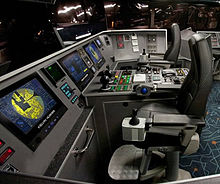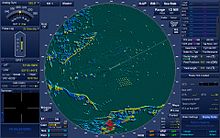- Marine radar
-
Marine Radars are x-band or s-band radar to provide bearing and distance of ships and land targets in vicinity from own ship (radar scanner) for collision avoidance and navigation at sea.
In port or in harbour, Vessel traffic service radar systems are used to monitor and regulate ship movements in busy waters.
Contents
Collision avoidance
As required by COLREGS, all ships shall maintained a proper radar lookout if it is available onboard to obtain early warning of risk of collision. Radar plotting or ARPA should be used to get the information of movement and the risk of collision (bearing, distance, CPA, TCPA) of other ships in vicinity.
Marine radar systems can provide very useful radar navigation information for navigators onboard ships. Ship position could be fixed by the bearing and distance information of land target on radar screen.
Radar Controls
Marine radar has performance adjustment controls for brightness and contrast, gain, tuning, sea clutter and rain clutter suppression, and other interference reduction. Other common controls consist of range scale, bearing cursor, fix/variable range marker or bearing/distance cursor.
Watson Radar Power Conjecture
The Watson Conjecture is a conjecture about the range of a maritime radar is affected by pulse length as opposed to its amplitude. The radar range equation states the maximum theoretical range of a radar system based on the output power and sensitivity of the receiver. It may be modified by taking into account the curvature of the earth. This drastically reduces the range for maritime radars. In order to increase range maritime radars increase the Pulse Repetition Rate (PRF). PRF is in essence how often the magnetron is fired per second. In essence this means that the actual range is affected by the number of pulses that are fired and NOT the amplitude. Convention would have us believe that the amplitude of the pulse should affect the range. Consider a light in a window, we are sitting 1 mile away, the light is switched on for a minute, we are looking at the window and don't see it. If the light is on for two minutes would we see it? No. In order to make if visible at 1 mile we would increase the brightness (or it's amplitude)! In the world of RADAR to increase the range one can lengthen the pulse length. Whilst the total amount of energy has increased the amplitude has not. Watson postulated that the reason range increased as pulse length increased was due to probability, If the pulse length is longer then the probability that an echo will return is increased thus increasing the effective range of the system.
Phil Watson BEng, CEng, MIEI is a Radar Consultant in Naval Radar. His full paper 'Statistical Anomalies in Radar Radiation' is classified however an excerpt on Radar Power conjecture was released in print format in 1990, it is also briefly mentioned on the authors website, link below.
References
http://www.calculatoredge.com/calc/radar.htm http://en.wikipedia.org/wiki/Radar
External links
- http://www.radartutorial.eu/01.basics/rb13.en.html
- http://earth.esa.int/applications/data_util/SARDOCS/spaceborne/Radar_Courses/Radar_Course_III/radar_equation.htm
- http://www.alphalpha.org/radar/intro_e.html#Portata%20non%20ambigua
- http://www.macuait.com/index.php/research/14-watson-radar-conjecture
External links
Categories:
Wikimedia Foundation. 2010.


